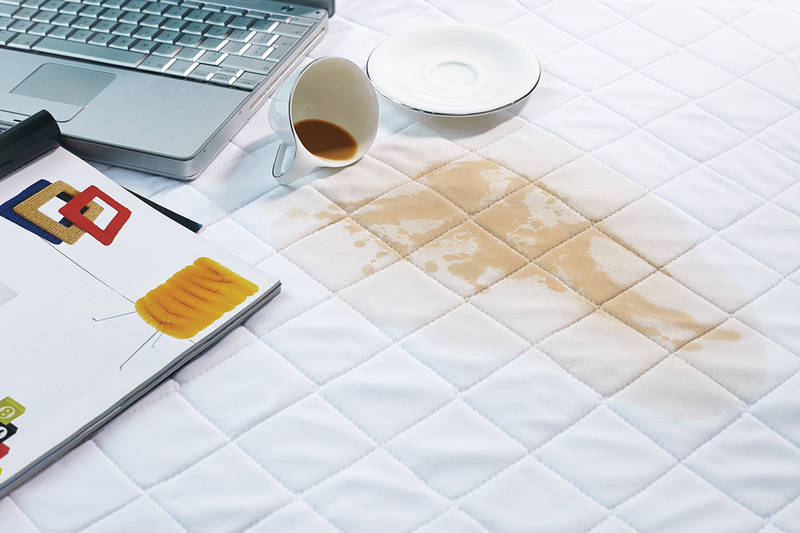End Grease for Good: A Step-by-Step Enamel Tray Cleaning Guide
Posted on 03/06/2025
End Grease for Good: A Step-by-Step Enamel Tray Cleaning Guide
Is your enamel tray looking dull, sticky, or covered in stubborn grease? Whether you use it for roasting, baking, grilling, or serving, a sparkling clean enamel tray enhances both food safety and presentation. Over time, however, oil, burnt-on residue, and stains can accumulate, making it challenging to maintain that fresh, pristine look. Don't worry--our comprehensive, step-by-step enamel tray cleaning guide will help you banish grease for good and keep your trays looking brand new. Discover powerful techniques, eco-friendly remedies, and expert tips for lasting cleanliness.
Why Choosing the Right Enamel Tray Cleaning Method Matters
Enamelware is celebrated for its durability, heat distribution, and non-stick qualities. However, improper cleaning can result in chips, discoloration, and a decrease in lifespan.
- Preserves the finish: Appropriate cleaning stops scratches and erosion.
- Ensures food safety: A spotless tray prevents harmful bacteria and burnt flavors.
- Boosts tray longevity: Gentle yet effective methods help enamel trays last for years.
Let's look at the best ways to remove grease from enamel bakeware and keep those trays perfectly clean--effortlessly!

Understanding Enamel: What Makes It Special?
Enamel-coated metal trays boast a glass-like surface fused to steel or iron. This enamel finish prevents rust, imparts non-stick qualities, and delivers a smooth, glossy look. However, the enamel layer can be damaged by abrasive tools, harsh chemicals, or extreme thermal shock. Understanding these qualities is key to effective yet gentle cleaning.
Common Challenges with Enamel Tray Cleaning
- Burnt-on grease: Accumulated fat and oils from roasting and baking can carbonize and stick tenaciously.
- Discoloration: Overcooked sauces and high-temperature baking may stain the glossy enamel surface.
- Residue build-up: Dish soap alone might leave an oily film, making the tray look dull or filmy.
- Cracks and chips: Improper scraping or cleaning may damage the enamel finish.
To end grease for good on enamel trays, follow our tested multi-step regime. Read on for not only the best cleaning practices but also common mistakes to avoid.
Essential Supplies for Cleaning Enamel Trays
Before you begin, gather the right materials to make your tray cleaning process seamless and safe for the enamel finish.
- Mild dish soap (preferably eco-friendly)
- Soft non-scratch sponges or microfiber cloths
- Baking soda (for a gentle, natural abrasive)
- White vinegar
- Hot water
- Plastic or silicone scraper
- Optional: Lemon juice, hydrogen peroxide (for stubborn stains), rubber gloves
Step-by-Step Guide: How to Clean Enamel Trays and End Grease for Good
Step 1: Cool Down and Pre-Rinse
- Allow your enamel tray to cool before cleaning. Rapid temperature changes may crack the finish.
- Once cool, rinse the tray under hot water to loosen grease and soften hardened food bits.
Step 2: Soak and Loosen Stubborn Grease
- Prepare a solution of hot water and a squirt of dish soap in your sink or a basin.
- Submerge the tray and let it soak for at least 20-30 minutes. This softens grease, making it easier to remove.
- If the tray is oversized, saturate a pliable towel with the solution and lay it directly over grease spots.
Step 3: Apply Baking Soda Paste
- Mix baking soda and a little water in a bowl until it forms a thick paste.
- Spread the paste onto stubborn stains, burnt spots, or greasy residue.
- Allow the paste to sit on the tray for another 20 minutes for maximum effect.
Why baking soda? Its gentle abrasiveness lifts off cooked-on debris without scratching the glassy enamel surface.
Step 4: Gentle Scrubbing
- Use a soft sponge or microfiber cloth--a non-abrasive scrubber--to work on the stains.
- For persistent bits, use a plastic or silicone scraper (never metal) for extra power.
- Always scrub in a circular motion to protect the enamel coating.
Step 5: Tackle Lingering Stains
- Make a solution of equal parts white vinegar and hot water. Pour into the tray and let sit for 10-15 minutes.
- Gently scrub again with your sponge.
- Repeat until your enamel tray is brilliantly clean and grease-free.
- Optional: Add a touch of lemon juice to the vinegar solution for extra stain-fighting power and a fresh scent.
Step 6: Rinse and Dry Thoroughly
- Rinse the tray under warm running water, ensuring all cleaning agents are removed.
- Wipe dry with a lint-free towel or air-dry on a rack.
Pro Tips to Maintain and Protect Your Enamel Tray
- Avoid thermal shock: Do not submerge a hot tray in cold water.
- Skip the steel wool: Never use metal brushes or abrasive powders--they will scratch the enamel.
- Store safely: Protect the surface by avoiding stacking with other heavy cookware.
- Routine cleaning: After every use, do a quick wash even if no visible residue remains. This stops grease from building up.
- Oven cleaning cycles: Never place enamel trays in the self-cleaning oven feature, as this can destroy the enamel layer.
- Spot cleaning: For minor stains, try a spot-clean with a damp cloth and a sprinkle of baking soda.
Deep Cleaning Methods for Heavily Greased or Burnt Enamel Trays
If your enamel tray has been neglected or exposed to especially greasy, burnt-on messes, try these advanced cleaning techniques:
1. Hydrogen Peroxide and Baking Soda Soak
- Sprinkle baking soda generously across the tray surface.
- Pour a thin layer of 3% hydrogen peroxide over the soda.
- Let it bubble and work for 30-60 minutes.
- Gently scrub and rinse thoroughly.
2. Overnight Soak for Tough Grease
- Mix a cup of baking soda and a cup of vinegar in the tray; add enough hot water to cover greasy areas.
- Let the solution sit overnight; the fizzing action helps dissolve burned fat and oils.
- Scrub off any residue the next morning, rinse, and dry.
The Best Natural Cleaners for Enamel Bakeware
Sometimes commercial cleaners leave a chemical smell or may degrade the enamel finish. Here are some natural alternatives to remove grease from enamel bakeware safely:
- Baking soda: Lifts burnt-on residue and degreases surfaces without harm.
- White vinegar: Breaks down tough deposits while disinfecting.
- Lemon juice: Naturally acidic, great for whitening and deodorizing.
- Coarse salt: Sprinkle onto a damp sponge to remove debris without scratching.
DIY Enamel Tray Cleaning Paste Recipe
Mix equal parts baking soda and lemon juice with a splash of vinegar until you get a foamy paste. Apply it, let it sit, and scrub for a sparkling tray!
What NOT to Do: Avoid These Enamel Tray Cleaning Mistakes
Even well-meaning kitchen enthusiasts can inadvertently damage their enamelware. Watch out for these common pitfalls:
- Avoid metal utensils during cleaning and cooking--these can crack, chip, or scratch the enamel surface.
- Stay away from chlorine-based bleaches or harsh chemicals--these may erode the glossy coating.
- Resist excessive force; stubborn debris is best tackled by soaking, not scraping harder.
- Do not use your enamel tray directly on electric or open flames unless the manufacturer specifies it's safe.
How Often Should You Clean Your Enamel Trays?
Immediate cleaning is always best. After each use, rinse and wash your tray even if it doesn't look dirty. This simple habit prevents grease from sticking and hardening--and also extends the life of your enamel cookware. For deep cleaning, target once a month or whenever you notice build-up or stains appearing.
When to Replace Your Enamel Tray
If you notice cracks, chips with exposed metal, or flaking enamel, it's time to retire the tray. Damaged enamel can harbor bacteria and may further leach metals or rust into your food. For minor cosmetic chips, food-grade enamel repair kits may be an option, but check the manufacturer's guidance first.

Frequently Asked Questions (FAQ)
- Can I put enamel trays in the dishwasher?
A: Most modern enamel trays are technically dishwasher safe, but hand-washing is always safer and prolongs shine. Dishwasher detergents can dull and eventually erode the enamel coating over time. - How do I get rid of blackened, burnt-on stains?
A: Use a hydrogen peroxide and baking soda soak or a baking soda and vinegar paste, letting it sit overnight if needed. Never use metal scouring pads. - Can I restore the shine to a dull enamel tray?
A: Yes! Polish with a paste of baking soda and lemon juice, rinse, and buff with a microfiber cloth. - Is it safe to use lemon or vinegar regularly?
A: Absolutely. Both are pH-balanced to clean and deodorize without harm. - What about old enamel trays with significant rust?
A: If rust has penetrated the enamel, replacement is best for food safety.
Conclusion: Sparkling Enamel Trays, Grease-Free for Good
Your enamel trays are true kitchen workhorses. By following this step-by-step cleaning guide, you can end grease for good and revive the beauty and function of your enamelware with minimal effort. Remember to treat your trays with care, stick to gentle cleaning agents, and make immediate, routine washing a part of your cooking habits. With these techniques and a little extra attention, your enamel trays will serve up delicious meals and look immaculate for years to come.
Ready to say goodbye to grease forever? Try these tricks today and enjoy the sparkling results!





